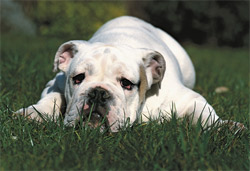Dog Heatstroke Survival Guide

When my Pharaoh Hound, Logan, joined the family, I had the opportunity to try dog sports I had not yet experienced. It started out innocently enough with conformation events, but while working on conformation, I decided to try Logan in lure coursing. Logan turned out to be a natural, and has been awarded multiple Best-in-Field titles.
Agility, disc-dog competition, conformation and lure coursing are offered year-round, rain or shine. About a month ago, I experienced a problem I had never encountered. For the first time in almost a decade of competing in dog sports, one of my dogs experienced heatstroke. At a lure-coursing event, Logan became overheated. He’s completely recovered now, with no apparent long-term negative effects, but it was an experience that demonstrated firsthand how quickly this potentially life-threatening condition can arise.
What is heatstroke?
In simple terms, heatstroke occurs when a dog loses its natural ability to regulate its body temperature. Dogs don’t sweat all over their bodies the way humans do. Canine body temperature is primarily regulated through respiration (i.e., panting). If a dog’s respiratory tract cannot evacuate heat quickly enough, heatstroke can occur.
To know whether or not your dog is suffering from heatstroke (as opposed to merely heat exposure), it’s important to know the signs of heatstroke.
A dog’s normal resting temperature is about 100.5 to 102.5 degrees Fahrenheit. Once a dog’s temperature rises above 105 degrees, physiological changes start to take place, and the dog begins to experience the effects of heatstroke. At 106 to 108 degrees, the dog begins to suffer irreversible damage to the kidneys, liver, gastrointestinal tract, heart and brain.
If a dog is experiencing heatstroke, you may observe excessive panting; hyperventilation; increased salivation; dry gums that become pale, grayish and tacky; rapid or erratic pulse; weakness; confusion; inattention; vomiting; diarrhea; and possible rectal bleeding. If the dog continues to overheat, breathing efforts become slowed or absent, and finally, seizures or coma can occur.
The amount of damage a dog sustains when stricken with heatstroke depends on the magnitude and duration of the exposure. The longer and more severe the exposure, the worse the damage will be.
What to do:
Pay attention to your dog. Recognizing the symptoms of heatstroke and responding quickly is essential for the best possible outcome.
Get into the shade. If you think your dog is suffering from heatstroke, move it into a shaded area and out of direct sunlight. Apply cool water to the inner thighs and stomach of the dog, where there’s a higher concentration of relatively superficial, large blood vessels. Apply cool water to the foot pads, as well.
Use running water. A faucet or hose is the best way to wet down your dog’s body. Never submerge your dog in water, such as in a pool or tub – this could cool the dog too rapidly, leading to further complications, including cardiac arrest and bloating.
Use cool – not cold – water. Many people make the mistake of using cold water or ice to cool the dog. When faced with a dog suffering from heatstroke, remember that the goal is to cool the dog. Using ice or extremely cold water is actually counterproductive to this process because ice and cold water cause the blood vessels to constrict, which slows blood flow, thus slowing the cooling process.
Don’t cover the dog. One of the keys to successfully cooling your dog is ensuring the water being placed on the dog can evaporate. Never cover an overheated dog with a wet towel or blanket. This inhibits evaporation and creates a sauna effect around your dog’s body. Likewise, don’t wet the dog down and put it into an enclosed area, such as a kennel. Any air flow during the cooling process is helpful in reducing the dog’s body temperature. Sitting with the wet dog in a running car with the air conditioner blowing is an ideal cooling situation.
Keep the dog moving. It’s important to try to encourage your dog to stand or walk slowly as it cools down. This is because the circulating blood tends to pool in certain areas if the dog is lying down, thus preventing the cooled blood from circulating back to the core.
Allow the dog to drink small amounts of water. Cooling the dog is the first priority. Hydration is the next. Don’t allow the dog to gulp water. Instead, offer small amounts of water that’s cool, but not cold. If the dog drinks too much water too rapidly, it could lead to vomiting or bloat.
Avoid giving human performance drinks. Performance beverages designed for humans are not recommended because they are not formulated with the canine’s physiology in mind. If you can’t get an overheated dog to drink water, try offering chicken- or beef-based broths.
« 9 Things You Need to Know About Your Senior Dog’s Diet Needs Next Post
Healing Puppy Power Put to Test for Childhood Cancer »





